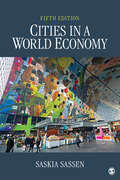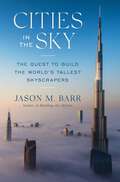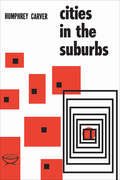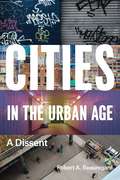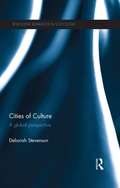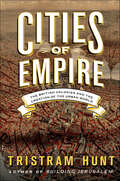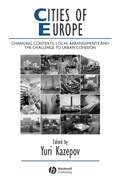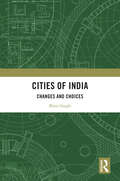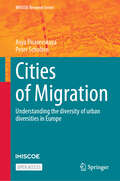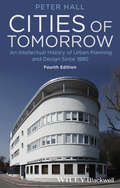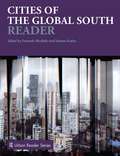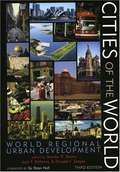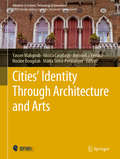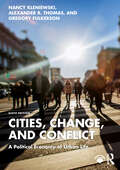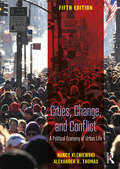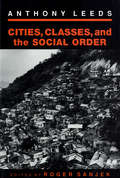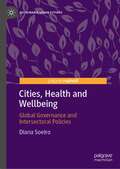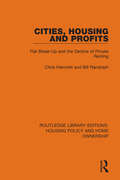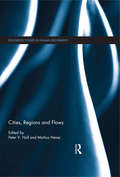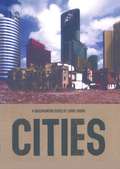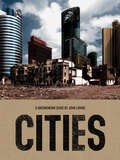- Table View
- List View
Cities in a World Economy
by Saskia SassenCities in a World Economy, Fifth Edition examines the emergence of global cities as a new social formation. As sites of rapid and widespread developments in the areas of finance, information and people, global cities lie at the core of the major processes of globalization. The book reflects the most current data available and explores recent debates such as the role of cities in mitigating environmental problems, the global refugee crisis, Brexit, and the rise of Donald Trump in the United States
Cities in the Sky: The Quest to Build the World's Tallest Skyscrapers
by Jason M. BarrFrom one of the world&’s top experts on the economics of skyscrapers—a fascinating account of the ever-growing quest for super tall buildings across the globe.The world&’s skyscrapers have brought us awe and wonder, and yet they remain controversial—for their high costs, shadows, and overt grandiosity. But, decade by decade, they keep getting higher and higher. What is driving this global building spree of epic proportions? In Cities in the Sky, author Jason Barr explains all: why they appeal to cities and nations, how they get financed, why they succeed economically, and how they change a city&’s skyline and enable the world&’s greatest metropolises to thrive in the 21st century. From the Empire State Building (1,250 feet) to the Shanghai Tower (2,073 feet) and everywhere in between, Barr explains the unique architectural and engineering efforts that led to the creation of each. Along the way, Barr visits and unpacks some surprising myths about the earliest skyscrapers and the growth of American skylines after World War II, which incorporated a new suite of technologies that spread to the rest of the world in the 1990s. Barr also explores why London banned skyscrapers at the end of the 19th century but then embraced them in the 21st and explains how Hong Kong created the densest cluster of skyscrapers on the planet. Also covered is the dramatic result of China&’s &“skyscraper fever&” and then on to the Arabian Peninsula to see what drove Dubai to build the world&’s tallest building, the Burj Khalifa, which at 2,717 feet, is higher than the new One World Trade Center in New York by three football fields. Filled with fascinating details for urbanists, architecture buffs, and urban design enthusiasts alike, Cities in the Sky addresses the good, bad, and ugly for cities that have embraced vertical skylines and offers us a glimpse to the future to see whether cities around the world will continue their journey ever upwards.
Cities in the Suburbs
by Humphrey CarverWe are all familiar with the almost ritual lament about the desolation and sameness of the suburbs that surround our modern cities. Is this complaint inevitable or can something be done to lend variety, colour, and meaning to these spreading areas? In a book full of good questions and apt illustrations, Mr. Carver examines what has provided a sense of community for city groupings of the past and how leading planners of our day (Ebenezer Howard, Frank Lloyd Wright) have suggested it be found for modern cities.His own proposal for achieving this goal is a very simple one and originates in the earlier views of a city as a place in which an urban society achieves its individual character by congregating around its own social institutions. Somehow today we have to recover this simple idea about a city and apply it to the contemporary sprawling urban region."The exposing metropolis" is a good descriptive term for the modern city, with its social institutions removed from the original centre and scattered into the suburbs. Now we should try to rearrange suburban growth so that each new community can grow up around its own vigorous and attractive "Town Centre," a place that can command the interest and pride of those who live immediately around it. These small cities in our suburbs would not just be dormitories for their central core city, but rather communities in their own right and the new kind of town centre would give a focus for their social, political, and cultural life.The idea of metropolitan or regional government for large urban areas has been much debated in Canada. But there has not been a clear view of how such governments could give birth to new daughter communities around them. The establishment of new "Town Centres" in growing suburban areas would be a workable method of helping these new settlements through a period of growth. Housing and commercial developments would then be able to gather in an organized fashion around the focal point in a regional plan. It is hoped this suggestion will be taken up by local politicians and their professional staffs but they cannot steer towards long-term objectives of this kind unless the general public understands the general philosophy involved.This is a lively book, hopeful in its suggestions and cheerful in its phrasing, and it should provoke eager discussion. It is illustrated with unusual line drawings to point up the argument and with many photographs.
Cities in the Urban Age: A Dissent
by Robert A. BeauregardWe live in a self-proclaimed Urban Age, where we celebrate the city as the source of economic prosperity, a nurturer of social and cultural diversity, and a place primed for democracy. We proclaim the city as the fertile ground from which progress will arise. Without cities, we tell ourselves, human civilization would falter and decay. In Cities in the Urban Age, Robert A. Beauregard argues that this line of thinking is not only hyperbolic—it is too celebratory by half. For Beauregard, the city is a cauldron for four haunting contradictions. First, cities are equally defined by both their wealth and their poverty. Second, cities are simultaneously environmentally destructive and yet promise sustainability. Third, cities encourage rule by political machines and oligarchies, even as they are essentially democratic and at least nominally open to all. And fourth, city life promotes tolerance among disparate groups, even as the friction among them often erupts into violence. Beauregard offers no simple solutions or proposed remedies for these contradictions; indeed, he doesn’t necessarily hold that they need to be resolved, since they are generative of city life. Without these four tensions, cities wouldn’t be cities. Rather, Beauregard argues that only by recognizing these ambiguities and contradictions can we even begin to understand our moral obligations, as well as the clearest paths toward equality, justice, and peace in urban settings.
Cities of Banal Warfare: Affective Geographies in Violent Times
by Sunčana LaketaAvailable open access digitally under CC-BY-NC-ND licence. “Banal warfare” describes the ways in which the vision of the city—ridden with conflicts, terrorist attacks and disease—infuses everyday urban life, to the point of becoming invisible. This book analyzes the impact of framing public emergencies and violences in Paris and Brussels as acts of war and how this normalizes militarism within urban contexts traditionally viewed as “non-war zones”. It addresses how this process shapes urban governance agendas, constructs the notion of the “enemy within,” and conditions everyday lives. From lockdowns to states of emergency, the book considers urban citizens’ agency and resistance, and how to rethink notions of urban peace.
Cities of Culture: A Global Perspective (Routledge Advances in Sociology)
by Deborah StevensonCulture now has a prominent place on the urban policy and re-profiling agendas of cities around the world. City-based cultural planning emphasising creativity in all its guises has emerged as a significant local policy initiative, while the notion of the ‘creative city’ has become an urban imaging cliché. The proliferation of local blueprints for cultural planning/creative cities has been remarkable, while supra-state bodies such as the European Union and UNESCO are also fostering the use of culture in strategies to revive cities and urban economies and to brand places as ‘different’. Cities of Culture highlights significant trends in cultural planning since its inception, revealing and analysing key discourses and influential (globally-circulating) manifestos and processes, as well as their interpretation and implementation in specific places. With reference to examples drawn from Europe, Australia, Asia and North America, Cities of Culture provides insights into the application of urban cultural strategies in different local, national and international contexts, highlighting regularities, tensions and intersections as well as core underpinning assumptions. This book explores the now-pervasive expectation that cultural planning is capable of achieving a wide range of social, economic, urban and creative outcomes. It will be of interest for students and scholars of urban sociology, urban studies, cultural policy studies and human geography.
Cities of Empire: The British Colonies and the Creation of the Urban World
by Tristram HuntAn original history of the most enduring colonial creation, the city, explored through ten portraits of powerful urban centers the British Empire left in its wakeAt its peak, the British Empire was an urban civilization of epic proportions, leaving behind a network of cities which now stand as the economic and cultural powerhouses of the twenty-first century. In a series of ten vibrant urban biographies that stretch from the shores of Puritan Boston to Dublin, Hong Kong, New Delhi, Liverpool, and beyond, acclaimed historian Tristram Hunt demonstrates that urbanism is in fact the most lasting of Britain's imperial legacies.Combining historical scholarship, cultural criticism, and personal reportage, Hunt offers a new history of empire, excavated from architecture and infrastructure, from housing and hospitals, sewers and statues, prisons and palaces. Avoiding the binary verdict of empire as "good" or "bad," he traces the collaboration of cultures and traditions that produced these influential urban centers, the work of an army of administrators, officers, entrepreneurs, slaves, and renegades. In these ten cities, Hunt shows, we also see the changing faces of British colonial settlement: a haven for religious dissenters, a lucrative slave-trading post, a center of global hegemony.Lively, authoritative, and eye-opening, Cities of Empire makes a crucial new contribution to the history of colonialism.
Cities of Europe: Changing Contexts, Local Arrangement and the Challenge to Urban Cohesion (IJURR Studies in Urban and Social Change Book Series #46)
by Yuri KazepovCities of Europe is a unique combination of book and CD-ROM examining the effects of recent socio-economic transformations on western European cities. A unique combination of book and CD-ROM examining the effects of recent socio-economic transformations on western European cities. Focuses on the interplay between segregation, social exclusion and governance issues in these cities. Takes a comparative approach by highlighting the specifics of European cities vis-à-vis other urban contexts and analysing the intra-European differences. The CD-ROM features a series of 2,000 photographs from seventeen cities (Amsterdam, Antwerp, Barcelona, Berlin, Birmingham, Brussels, Bucharest, Helsinki, London, Milan, Naples, New York, Paris, Rotterdam, Tirana, Turin, and Utrecht). Also features 126 thematic maps, interviews with established scholars, and literature reviews. The book and the CD-ROM are linked through an extensive cross-referencing system.
Cities of India: Changes and Choices
by Binti SinghUrban India stands at an interesting moment in history—at the cusp of massive changes and cautious choices. This book maps the new challenges and subsequent choices that emerge as India transitions into more urbanized situations, both spatially and culturally—to cleaner and renewable energy, integrating these new norms into the built environment, providing affordable and accessible physical and social infrastructure to all citizens, addressing the disproportionate climate risks of vulnerable communities, responding to the forces of globalization, conserving our heritage assets, deploying smart technologies for better city governance, designing for all, integrating hard and soft city dimensions for better policy outcomes and greater environmental and social impacts. It underlines and explores the nuances of urban design and urban planning, as well as how they are inextricably enmeshed with sustainability and climate action.The volume will be of great interest to scholars and researchers of urban studies, sociology, South Asian Studies, built environment, sustainability and climate studies, urban design and urban planning.
Cities of Migration: Understanding the diversity of urban diversities in Europe (IMISCOE Research Series)
by Peter Scholten Asya PisarevskayaThis open access book develops a typology of cities by exploring how current levels of migration-related diversity and segregation relate to three groups of factors: international mobilities, inequalities and political-institutional aspects of local governance. Based on both quantitative and qualitative data from 16 cities in four European countries (France, Germany, The Netherlands, and Italy), the book compares the cities and uses a method of fuzzy-set Qualitative Comparative Analysis. It demonstrates the shared contingencies of factors among the cities within each type and the crucial differences between the types of localities, and offers a more differentiated, holistic understanding of migration-related diversity configurations through the five conceptualised types: (1) Superdiverse cities, (2) Postindustrial diverse cities. (3) Middle class diverse cities, (4) Divided cities, and (5) Marginal migration cities. As such, the book is a valuable read to all those who would like to learn more about urban migration-related diversity and how it is formed and governed.
Cities of Oil
by Timothy CobbanCities of Oil is the first sustained historical account of the development of the early Canadian petroleum refining and manufacturing industry. In it, Timothy W. Cobban documents the industry's development in southern Ontario, from its beginnings in the 1850s to its later expansion on the outskirts of London, to Petrolia, and finally to Sarnia. He accounts for all of the industry's important developments and innovations, particularly the role played by municipalities in fostering its growth.Using extensive archival research, Cobban concludes that municipalities can stimulate the accelerated, sustained development of local industry sectors, thus challenging the dominant view that the influence of municipalities on economic growth is marginal. Cities of Oil demonstrates the importance of accommodating the land and infrastructure needs of industry at critical junctures, and implementing land use policies that encourage the dense clustering of industries. This book will be essential reading for those seeking a greater understanding of industrial growth in the province of Ontario.
Cities of Tomorrow
by Peter HallPeter Hall's seminal Cities of Tomorrow remains an unrivalled account of the history of planning in theory and practice, as well as of the social and economic problems and opportunities that gave rise to it. Now comprehensively revised, the fourth edition offers a perceptive, critical, and global history of urban planning and design throughout the twentieth-century and beyond.A revised and updated edition of this classic text from one of the most notable figures in the field of urban planning and designOffers an incisive, insightful, and unrivalled critical history of planning in theory and practice, as well as of the underlying socio-economic challenges and opportunitiesComprehensively revised to take account of abundant new research published over the last decadeReviews the development of the modern planning movement over the entire span of the twentieth-century and beyondDraws on global examples throughout, and weaves the author's own fascinating experiences into the text to illustrate this authoritative story of urban growth
Cities of the Global South Reader (Routledge Urban Reader Series)
by Faranak Miraftab and Neema KudvaThe Cities of the Global South Reader adopts a fresh and critical approach to the fi eld of urbanization in the developing world. The Reader incorporates both early and emerging debates about the diverse trajectories of urbanization processes in the context of the restructured global alignments in the last three decades. Emphasizing the historical legacies of colonialism, the Reader recognizes the entanglement of conditions and concepts often understood in binary relations: first/third worlds, wealth/poverty, development/underdevelopment, and inclusion/exclusion. By asking: “whose city? whose development?” the Reader rigorously highlights the fractures along lines of class, race, gender, and other socially and spatially constructed hierarchies in global South cities. The Reader’s thematic structure, where editorial introductions accompany selected texts, examines the issues and concerns that urban dwellers, planners, and policy makers face in the contemporary world. These include the urban economy, housing, basic services, infrastructure, the role of non-state civil society-based actors, planned interventions and contestations, the role of diaspora capital, the looming problem of adapting to climate change, and the increasing spectre of violence in a post 9/11 transnational world. The Cities of the Global South Reader pulls together a diverse set of readings from scholars across the world, some of which have been written specially for the volume, to provide an essential resource for a broad interdisciplinary readership at undergraduate and postgraduate levels in urban geography, urban sociology, and urban planning as well as disciplines related to international and development studies. Editorial commentaries that introduce the central issues for each theme summarize the state of the field and outline an associated bibliography. They will be of particular value for lecturers, students, and researchers, making the Cities of the Global South Reader a key text for those interested in understanding contemporary urbanization processes.
Cities of the World: World Regional Urban Development
by Stanley D. Brunn Donald J. Zeigler Jack WilliamsThe third edition features mainly new authors (most teach geography and urban studies in the US) and much revision to reflect the major changes that have occurred since volume 2 was published in 1993, including terrorism, electronic resources, wireless communication, and global business. This edition now has two chapters on Latin America, Central Asia has been added, and the chapters on Europe have been consolidated. The focus continues to be the evolution of cities, settlement patterns, daily life, and urban problems and solutions. Annotation (c)2003 Book News, Inc., Portland, OR (booknews.com)
Cities on a Hill: A Journey Through Contemporary American Cultures
by Frances Fitzgerald"We must consider that we shall be A City Upon a Hill, the eyes of all people upon us," John Winthrop told his Pilgrim community crossing the Atlantic to found the Massachusetts Bay Colony. Four centuries later, Americans are still building Cities Upon a Hill. In Cities on a Hill Pulitzer Prize-winner Frances FitzGerald explores this often eccentric, sometimes prophetic inclination in America. With characteristic wit and insight she examines four radically different communities -- a fundamentalist church, a guru-inspired commune, a Sunbelt retirement city, and a gay activist community -- all embodying this visionary drive to shake the past and build anew. Frances FitzGerald here gives eloquent voice and definition to a quintessentially American impulse. It is a resonant work of literary imagination and journalistic precision.
Cities' Identity Through Architecture and Arts: Proceedings Of The International Conference On Cities' Identity Through Architecture And Arts (citaa 2017), May 11-13, 2017, Cairo, Egypt (Advances in Science, Technology & Innovation)
by Hocine Bougdah Antonella Versaci Nicola Cavalagli Yasser Mahgoub Marta Serra-PermanyerThis book covers a broad range of topics relating to architecture and urban design, such as the conservation of cities’ culture and identity through design and planning processes, various ideologies and approaches to achieving more sustainable cities while retaining their identities, and strategies to help cities advertise themselves on the global market.Every city has its own unique identity, which is revealed through its physical and visual form. It is seen through the eyes of its inhabitants and visitors, and is where their collective memories are shaped. In turn, these factors affect tourism, education, culture & economic prosperity, in addition to other aspects, making a city’s identity one of its main assets.Cities’ identities are constructed and developed over time and are constantly evolving physically, culturally and sociologically. This book explains how architecture and the arts can embody the historical, cultural and economic characteristics of the city. It also demonstrates how cities’ memories play a vital role in preserving their physical and nonphysical heritage. Furthermore, it examines the transformation of cities and urban cultures, and investigates the various new approaches developed in contemporary arts and architecture.Given its scope, the book is a valuable resource for a variety of readers, including students, educators, researchers and practitioners in the fields of city planning, urban design, architecture and the arts.
Cities, Change, and Conflict: A Political Economy of Urban Life
by Nancy Kleniewski Alexander R. Thomas Gregory FulkersonCities, Change, and Conflict was one of the first texts to embrace the perspective of political economy as its main explanatory framework, and then complement it with the rich contributions of human ecology as well as perspectives derived from critical approaches to social theory. Although its primary focus is on North American cities, the book contains several chapters on cities in other parts of the world, including the Global North and Global South. It provides both historical and contemporary accounts of the impact of globalization on urban development and urban institutions.This sixth edition features a new, groundbreaking chapter on the relationship between the physical environment and human settlements, including the urban-rural nexus. This edition also expands and updates coverage of recent trends such as the establishment and evolution of gay neighborhoods, the suburbanization of immigrant groups, the situation of the immigrant youth known as "Dreamers," the reverse migration of Blacks from the North to the South, and the proliferation of exurban communities. Beyond examining the dynamics that shape the form and functionality of cities, the text surveys the experience of urban life among different social groups, including a new perspective on intersectionality as it affects people’s experiences in cities. It illuminates the workings of the urban economy, local and federal governments, and the criminal justice system while addressing policy debates and decisions that affect almost every aspect of urbanization and urban life.
Cities, Change, and Conflict: A Political Economy of Urban Life (Sociology Ser.)
by Nancy Kleniewski Alexander R. ThomasCities, Change, and Conflict was one of the first texts to embrace the perspective of political economy as its main explanatory framework, and then complement it with the rich contributions found in the human ecology perspective. Although its primary focus is on North American cities, the book contains several chapters on cities in other parts of the world, including Europe and developing nations, providing both historical and contemporary accounts on the impact of globalization on urban development. This edition features new coverage of important recent developments affecting urban life, including the implications of racial conflict in Ferguson, Missouri , and elsewhere, recent presidential urban strategies, the new waves of European refugees, the long-term impacts of the Great Recession as seen through the lens of Detroit’s bankruptcy, new and emerging inequalities, and an extended look into Sampson’s Great American City. Beyond examining the dynamics that shape the form and functionality of cities, the text surveys the experience of urban life among different social groups, including immigrants, African Americans,women, and members of different social classes. It illuminates the workings of the urban economy, local and federal governments, and the criminal justice system, and also addresses policy debates and decisions that affect almost every aspect of urbanization and urban life.
Cities, Classes, and the Social Order (The Anthropology of Contemporary Issues)
by Roger Sanjek Anthony LeedsCities, Classes, and the Social Order brings together nine conceptual and theoretical essays by the influential anthropologist, Anthony Leeds (1925–1989), whose pioneering work in the anthropology of complex societies was built on formative personal and research experiences in both urban and rural settings in the United States, Brazil, Venezuela, and Portugal.Leeds brought to his anthropology a simultaneous concern for science and humanism, and for explanation and interpretation. He constructed a nuanced and intricate vision of the connections among ecology, technology, history, evolution, structure, process, power, culture, social organization, and human creativity. The essays in this book draw on his approach to demarcate the role of cities in human history, the use and abuse of class analysis, the bases of power in complex societies, and an agenda for ethnographic and social-historical research in the contemporary world.In addition to major but little-known writings and an important essay on Marx here published for the first time in English, a selection of Leeds's ethnographically and politically inspired poems are included, as are several of his professionally exhibited photographs. In addition, introductory essays by R. Timothy Sieber and Roger Sanjek chart the course of Leeds's career and the development of his theoretical viewpoint.
Cities, Disaster Risk and Adaptation (Routledge Critical Introductions to Urbanism and the City)
by Christine WamslerWorldwide, disasters and climate change pose a serious risk to sustainable urban development, resulting in escalating human and economic costs. Consequently, city authorities and other urban actors face the challenge of integrating risk reduction and adaptation strategies into their work. However, related knowledge and expertise are still scarce and fragmented. Cities, Disaster Risk and Adaptation explores ways in which resilient cities can be ‘built’ and sustainable urban transformations achieved. The book provides a comprehensive understanding of urban risk reduction and adaptation planning, exploring key theoretical concepts and analysing the complex interrelations between cities, disasters and climate change. Furthermore, it provides an overview of current risk reduction and adaptation approaches taken by both city authorities and city dwellers from diverse contexts in low, middle and high income nations. Finally, the book offers a planning framework for reducing and adapting to risk in urban areas by expanding on pre-existing positive actions and addressing current shortfalls in theory and practice. The importance of a distributed urban governance system, in which institutions’ and citizens’ adaptive capacities can support and complement each other, is highlighted. This book takes a holistic approach; it integrates perspectives and practice from risk reduction and climate change adaptation based on a specific urban viewpoint. The text is richly supplemented with boxed case studies written by renowned academics and practitioners in the field and ‘test yourself’ scenarios that integrate theory into practice. Each chapter contains learning objectives, end of chapter questions, suggested further reading and web resources, as well as a wealth of tables and figures. This book is essential reading for undergraduate and postgraduate students of geography, urban studies and planning, architecture, environmental studies, international development, sociology and sustainability studies.
Cities, Health and Wellbeing: Global Governance and Intersectoral Policies (Sustainable Urban Futures)
by Diana SoeiroOn 25 September 2015, the United Nations General Assembly unanimously adopted Resolution 70/1, “Transforming our World: the 2030 Agenda for Sustainable Development”. Also known as 2030 Agenda, the document lays out 17 Sustainable Development Goals (SDGs) in the realm of ecology, society and economy. The current book focuses on three of these goals: SDG 16: Peace, Justice and Strong Institutions; SDG 3: Health and Wellbeing; SDG 11: Cities and Sustainable Communities. It is critical that interdisciplinary approaches go one step further and translate more effectively into intersectoral policies. This is particularly vital when it comes to urban planning and health. This book address the key question: In the context of a growing influence of European Union policies at a national level, can SDGs simultaneously contribute to harmonising sectoral policies and promoting intersectoral policies? Claiming a growing convergence between health and spatial planning, the main goal of the book is to formulate an answer to the following question: how can policymakers translate the SDGs effectively into public policies in order to improve cities, health and wellbeing?
Cities, Housing and Profits: Flat Break-Up and the Decline of Private Renting
by Chris Hamnett Bill RandolphOriginally published in 1988, this book documents and explains the emergence of flat ‘break-ups’ – the sale of individual owner occupation of blocks of flats which were previously privately rented and which played a major role in the transformation of the private housing market in London since the 1960s. The book shows that the flat break-up market in London was not a unique phenomenon but one of the most geographically concentrated manifestations of the trend for sales from private renting to owner occupation which has been established in the UK since the 1920s. The interrelationship between the causes of the decline of the privately rented sector in Britain and the features specific to the flat market comprises the second theme of the book.
Cities, Regions and Flows (Routledge Studies in Human Geography)
by Peter V. Hall Markus HesseUrban regions have come under increasing pressure to adapt to the imperatives of mobility, including greater freedom of travel, rising trade volumes and global economic networks. Whereas urbanization was once characterized by the concentration of services and facilities, urban areas now have to ensure the exchange of goods, services and information in a much more complex, interrelated, highly competitive, and spatially dispersed environment. As a consequence, cities are challenged to ensure the functionality of infrastructure while mitigating negative environmental and social impacts.Cities, Regions and Flows brings together debates in a single volume to present a theoretical framework for understanding the changing relationship between places and movement. It analyses the significance of flows of goods for urban and regional development and emphasises the twin processes of integration and disintegration that result from goods movement within urban space. It discusses urban regions as nodes for organizing the exchange of goods, services and information against a background of socio-economic and technological change, as well as new patterns of urbanization. The new logistics concepts and practices that have been developed in response to these changes exert both integrative and disintegrative effects on cities and regions. It also considers how urban policies are dealing with related challenges concerning infrastructure provision, land use, local labour markets and environmental sustainability.Cities, Regions and Flows contains thoughtfully prepared case studies from five different continents on how cities manage to become part of value chains and how they strive for accessibility in an increasingly competitive environment. This book will be on interest to policy-makers and advanced classes in planning, geography, urban studies and transportation.
Cities: A Groundwork Guide
by John LorincCities have always been the incubators of new ideas, economic innovation, and social reform. But recent demands and expectations placed on cities and their citizens are unprecedented: everything from chronic poverty and homelessness to massive energy consumption and nonstop suburban sprawl. In this timely book, cities specialist John Lorinc considers the enormous implications of the worldwide mass migration away from rural regions. He shows how solutions can emerge from neighborhoods and dynamic networks linking communities to governments and the broader urban world. Beyond the search for better housing, transit, economic opportunity, and security within neighborhoods, today's city-dwellers confront a fundamental question about what it means to live in our urban world. How do people from vastly different cultures and economic circumstances learn to accommodate one another's needs within the confines of very dense and complex mega-cities? This book offers a well-reasoned, creative answer to that question.
Cities: A Groundwork Guide (Groundwork Guides)
by John LorincA thought-provoking look at the demands and expectations we place on our growing cities in the twenty-first century. An excellent introduction to the subject for young adults. Today, more people live in cities than in rural areas. The search for better housing, transit, economic opportunity, and security within neighbourhoods forces today's city-dwellers -- in both the developed world and in megacities in Asia, Africa, and Latin America -- to confront what it means to live in our urban world. In this book, cities specialist John Lorinc considers the enormous implications of the mass migration away from rural regions, and predicts that solutions will emerge from neighbourhoods and dynamic networks linking communities to governments and the broader urban world. "[The Groundwork Guides] are excellent books, mandatory for school libraries and the increasing body of young people prepared to take ownership of the situations and problems previous generations have left them." -- Globe and Mail Correlates to the Common Core State Standards in English Language Arts: CCSS.ELA-LITERACY.RI.6.1 Cite textual evidence to support analysis of what the text says explicitly as well as inferences drawn from the text. CCSS.ELA-LITERACY.RI.6.2 Determine a central idea of a text and how it is conveyed through particular details; provide a summary of the text distinct from personal opinions or judgments. CCSS.ELA-LITERACY.RI.6.3 Analyze in detail how a key individual, event, or idea is introduced, illustrated, and elaborated in a text (e.g., through examples or anecdotes). CCSS.ELA-LITERACY.RI.6.4 Determine the meaning of words and phrases as they are used in a text, including figurative, connotative, and technical meanings. CCSS.ELA-LITERACY.RI.6.6 Determine an author's point of view or purpose in a text and explain how it is conveyed in the text.
